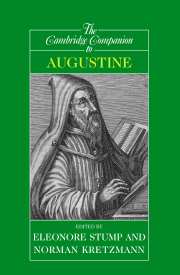Book contents
- Frontmatter
- Introduction
- 1 Augustine
- 2 Faith and reason
- 3 Augustine on evil and original sin
- 4 Predestination, Pelagianism, and foreknowledge
- 5 Biblical interpretation
- 6 The divine nature
- 7 De Trinitate
- 8 Time and creation in Augustine
- 9 Augustine’s theory of soul
- 10 Augustine on free will
- 11 Augustine’s philosophy of memory
- 12 The response to skepticism and the mechanisms of cognition
- 13 Knowledge and illumination
- 14 Augustine’s philosophy of language
- 15 Augustine’s ethics
- 16 Augustine’s political philosophy
- 17 Augustine and medieval philosophy
- 18 Post-medieval Augustinianism
- Bibliography
- Index
5 - Biblical interpretation
Published online by Cambridge University Press: 28 May 2006
- Frontmatter
- Introduction
- 1 Augustine
- 2 Faith and reason
- 3 Augustine on evil and original sin
- 4 Predestination, Pelagianism, and foreknowledge
- 5 Biblical interpretation
- 6 The divine nature
- 7 De Trinitate
- 8 Time and creation in Augustine
- 9 Augustine’s theory of soul
- 10 Augustine on free will
- 11 Augustine’s philosophy of memory
- 12 The response to skepticism and the mechanisms of cognition
- 13 Knowledge and illumination
- 14 Augustine’s philosophy of language
- 15 Augustine’s ethics
- 16 Augustine’s political philosophy
- 17 Augustine and medieval philosophy
- 18 Post-medieval Augustinianism
- Bibliography
- Index
Summary
Augustine began writing commentary on scripture not long after his conversion. His first such work, meant as a counterblast to Manichaean attacks on the creation account, was De Genesi contra Manichaeos (388-390). In many ways it sets the tone for much of his later work: Augustine admits an allegorical sense but warns against overenthusiasm for allegory and denigration of the literal sense; we see also from the outset Augustine's interest in scripture as a controversialist and polemicist. After his ordination to the priesthood in 391, he seems to have gone through something of a writer's block, starting but leaving incomplete a treatise on exegetical theory (De doctrina christiana, begun 396 but not completed until 427), another commentary on Genesis (De Genesi ad litteram imperfectus liber, 393-394), and an exposition of Romans (Epistolae ad Romanos inchoata expositio, 394-395). He did manage to finish a verse-by-verse commentary on Galatians, giving the literal sense (Epistolae ad Galatas expositio, 394-395) and a commentary on the Sermon on the Mount (De sermone Domini in monte, 393-396). His Expositio quarundam propositionum ex epistola ad Romanos (394) derives from conversations with the monks at Hippo, who recorded his answers to their questions about Romans; Augustine tells us later that he missed what he eventually came to see as the main point of the epistle.
- Type
- Chapter
- Information
- The Cambridge Companion to Augustine , pp. 59 - 70Publisher: Cambridge University PressPrint publication year: 2001
- 3
- Cited by



